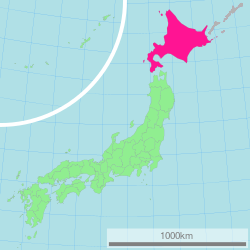Hokkaidō
|
Hokkaido 北海道 |
|||
|---|---|---|---|
| Prefecture | |||
| Japanese transcription(s) | |||
| • Japanese | 北海道 | ||
| • Rōmaji | Hokkaidō | ||
| Ainu transcription(s) | |||
| • Ainu | アィヌ・モシリ | ||
| • Rōmaji | Ainu-Mosir | ||
|
|||
 |
|||
| Country | Japan | ||
| Region | Hokkaido | ||
| Island | Hokkaido | ||
| Capital | Sapporo | ||
| Government | |||
| • Governor | Harumi Takahashi | ||
| Area | |||
| • Total | 83,453.57 km2 (32,221.60 sq mi) | ||
| Area rank | 1st | ||
| Population (June 30, 2016) | |||
| • Total | 5,381,711 | ||
| • Rank | 8th | ||
| • Density | 64.49/km2 (167.0/sq mi) | ||
| ISO 3166 code | JP-01 | ||
| Districts | 74 | ||
| Municipalities | 179 | ||
| Flower | Hamanasu (rugosa rose, Rosa rugosa) | ||
| Tree | Ezomatsu (Jezo spruce, Picea jezoensis) | ||
| Bird | Tanchō (red-crowned crane, Grus japonensis) | ||
| Fish | Sea bream | ||
| Website | www |
||
| Native name: 北海道(本島) | |
|---|---|
| Geography | |
| Location | Boundary between northwestern Pacific Ocean, Sea of Japan, and Sea of Okhotsk |
| Coordinates | 43°N 142°E / 43°N 142°E |
| Archipelago | Japanese archipelago |
| Area | 77,981.87 km2 (30,108.97 sq mi) |
| Highest elevation | 2,290 m (7,510 ft) |
| Highest point | Asahi-dake |
| Administration | |
|
Japan
|
|
| Prefectures | Hokkaido |
| Largest settlement | Sapporo (pop. 1,890,561) |
| Demographics | |
| Population | approx. 5,600,000 |
| Ethnic groups | Ainu, Japanese |
Hokkaido (北海道 Hokkaidō?, literally "Northern Sea Circuit") (Japanese: [hokkaidoː]), formerly known as Ezo, Yezo, Yeso, or Yesso, is the second largest island of Japan, and the largest and northernmost prefecture. The Tsugaru Strait separates Hokkaido from Honshu. The two islands are connected by the underwater railway Seikan Tunnel. The largest city on Hokkaido is its capital, Sapporo, which is also its only ordinance-designated city. About 43 km north of Hokkaido lies Sakhalin island, Russia, whereas to its east and north-east are the disputed Kuril Islands.
Hokkaido (北海道) was settled by the Ainu,Nivkh, and Orok before recorded history. The Nihon Shoki, finished in 720 AD, is often said to be the first mention of Hokkaido in recorded history. According to the text, Abe no Hirafu led a large navy and army to northern areas from 658 to 660 and came into contact with the Mishihase and Emishi. One of the places Hirafu went to was called Watarishima (渡島?), which is often believed to be present-day Hokkaido. However, many theories exist in relation to the details of this event, including the location of Watarishima and the common belief that the Emishi in Watarishima were the ancestors of the present-day Ainu people.
...
Wikipedia


